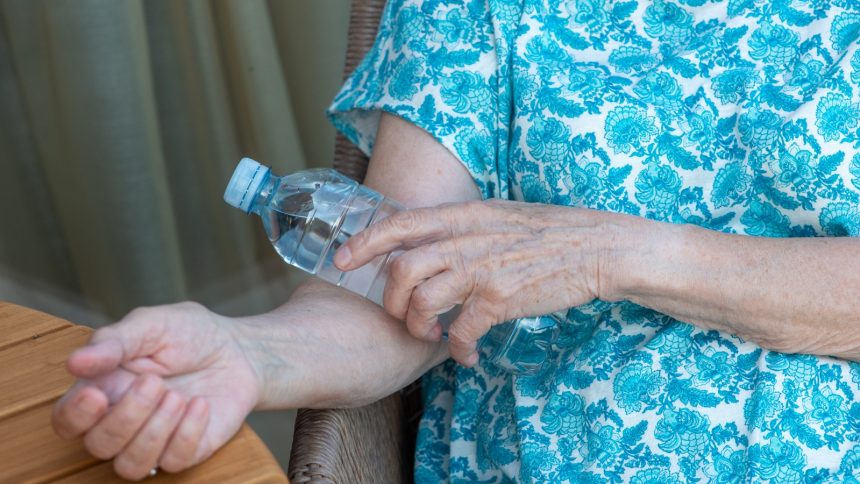This story was originally published by KFF Health News. Missoula is one of Montana’s largest cities but is surrounded by rural mountain communities where cattle ranching is king. Despite the latitude and altitude, in recent years this region has experienced punishing summer heat waves. It has been difficult for residents to adapt to the warming climate and new seasonal swings.
Many don’t have air conditioning and are unprepared for the new pattern of daytime temperatures hovering in the 90s — for days or even weeks on end. Dehydration, heat exhaustion, heatstroke, and abnormalities in heart rate and blood pressure are among the many health complications that can develop from excessive exposure to high temperatures. It can happen anywhere and to anyone, said Missoula firefighter Andrew Drobeck.
He remembers a recent 911 call. The temperature that day had risen to over 90 degrees and a worker at a local dollar store had fainted. “She’s sensitive to the heat. Their AC wasn’t working super good,” Drobeck said. “I guess they only get a 15-minute break.”
Drobeck said many of the heat calls his department receives are from seniors who struggle to stay cool inside their older homes. Montana’s population is among the oldest in the country. About 1 in 4 residents are over 60. Those over 65 are especially vulnerable to heat-related illness, according to the Centers for Disease Control and Prevention.
As people age, their bodies don’t acclimate to heat as well as they did when they were younger, including not producing as much sweat. In July, a heat dome that settled over much of the western U.S. baked the region and shattered two types of temperature records: daily highs, and number of consecutive days over 90 degrees. Although the Northwest, including western Montana, is typically cooler, the region experienced record-breaking heat this summer.
Emergency responders like Drobeck have noticed. Drobeck says 911 calls during heat waves have ticked up over the last few summers. But Missoula County officials wanted to know more: They wanted better data on the residents who were calling and the communities that had been hardest hit by the heat. So the county teamed up with researchers at the University of Montana to comb through the data and create a map of 911 calls during heat waves.
The team paired call data from 2020 with census data to see who lived in the areas generating high rates of emergency calls when it was hot. The analysis found that for every 1 degree Celsius (1.8 degree Fahrenheit) increase in the average daily temperature, 911 calls increased by 1 percent, according to researcher Christina Barsky, who co-authored the study.
Though that may sound like a small increase, Barsky explained that a 5-degree jump in the daily average temperature can prompt hundreds of additional calls to 911 over the course of a month. Those call loads can be taxing on ambulance crews and local hospitals.
The Missoula study also found that some of the highest rates of emergency calls during extreme heat events came from rural areas, outside Missoula’s urban core. That shows that rural communities are struggling with heat, even if they get less media attention, Barsky said.
“What about those people, right? What about those places that are experiencing heat at a rate that we’ve never been prepared for?” she said.
Barsky’s work showed that communities with more residents over 65 tend to generate more 911 calls during heat waves. That could be one reason so many 911 calls are coming from rural residents in Missoula County: Barsky said people living in Montana’s countryside and its small towns tend to be older and more vulnerable to serious heat-related illness. And aging in rural communities can pose extra problems during heat waves.
Even if it cools off at night, an older person living without air conditioning might not be able to cope with hours of high temperatures inside their home during the day. It’s not uncommon for rural residents to have to drive an hour or more to reach a library that might have air conditioning, a community center with a cooling-off room, or medical care.
Such isolation and scattered resources are not unique to Montana. “I grew up in the Upper Peninsula of Michigan,” Barsky said. “There are no air-conditioned spaces in at least 50 miles. The hospital is 100 miles away.”
Heat research like the Missoula study has focused mostly on large cities, which are often hotter than outlying areas, due to the “heat island” effect. This phenomenon explains why cities tend to get hotter during the day and cool off less at night: It’s because pavement, buildings, and other structures absorb and retain heat. Urban residents may experience higher temperatures during the day and get less relief at night.
By contrast, researchers are only just beginning to investigate and understand the impacts of heat waves in rural areas. The impacts of extreme heat on rural communities have largely been ignored, said Elizabeth Doran, an environmental engineering professor at the University of Vermont. Doran is leading an ongoing study in Vermont that is revealing that towns as small as 5,000 people can stay hotter at night than surrounding rural areas due to heat radiating off hot pavement.
“If we as a society are only focused on large urban centers, we’re missing a huge portion of the population and our strategies are going to be limiting in how effective they can be,” Doran said. Brock Slabach, with the National Rural Health Association, agrees that rural residents desperately need help adapting to extreme heat.
They need support installing air conditioning or getting to air-conditioned places to cool off during the day. Many rural residents have mobility issues or don’t drive much due to age or disability. And because they often have to travel farther to access health care services, extra delays in care during a heat-related emergency could lead to more severe health outcomes.
“It’s not unreasonable at all to suggest that people will be harmed from not having access to those kinds of services,” he said.
Helping rural populations adapt will be a challenge. People in rural places need help where they live, inside their homes, said Adriane Beck, director of Missoula County’s Office of Emergency Management.
Starting a cooling center in a small community may help people living in town, but it’s unrealistic to expect people to drive an hour or more to cool off. Beck said the Missoula County Disaster and Emergency Services Department plans to use data from the 911 study to better understand why people are calling in the first place.
In the coming years, the department plans to talk directly with people living in rural communities about what they need to adapt to rising temperatures. “It might be as simple as knocking on their door and saying, ‘Would you benefit from an air conditioner? How can we connect you with resources to make that happen?’” Beck said.
But that won’t be possible for every rural household because there simply isn’t enough money at the county and state level to pay for that many air-conditioning units, Missoula County officials said. That’s why the county wants to plan ahead for heat waves and have specific protocols for contacting and assisting vulnerable rural residents.
“Ideally, we’d be in a situation where maybe we have community paramedics that can be deployed into those areas when we know that these events are going to happen so they can check on them and avoid that hospital admission,” Beck explained. She added that preventing heat-related hospitalizations among rural residents can ultimately save lives.
This article is from a partnership that includes MTPR, NPR, and KFF Health News, a national newsroom that produces in-depth journalism about health issues. Subscribe to KFF Health News’ free Morning Briefing.
If the provided articles seem to be less than 200 characters or it is an intro of the author, then try to generate an article using this title. In Montana, 911 calls reveal the impact of heat waves on rural seniors.






